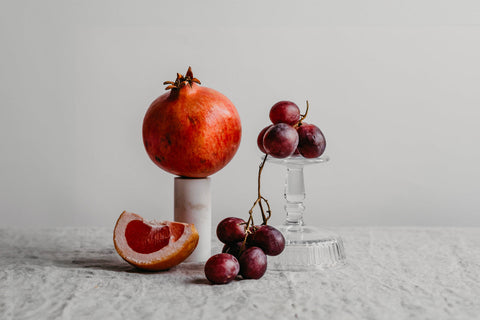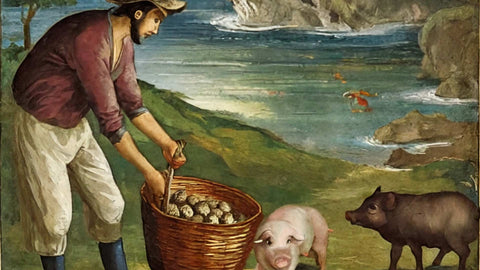“O hija, it’s 11:45 pm. Make sure you have coins in your pockets. Make sure you have grapes, ha. Eat them when the clock strikes 12,” my grandmother would say as she held out two bowls: one full of coins and another full of grapes. This was something I heard over and over from her every New Year’s Eve growing up.
During the last week of the year, local markets are suddenly bursting with round (and round-ish) fruit—grapes, oranges, watermelon, melons, kiwi, apples, pears, pineapples, mangosteen, mangoes. Regardless of their season, they are there, their auspicious shape being the important factor for this time of the year. I don’t think I’ve ever had very good January 2 watermelon, but we have it every year anyway. Tradition says you either must have eight (one for every day of the week, plus one) or 13 (one for every month of the year, plus one) on your table as you welcome the year like a very hospitable host to a fruit-loving VIP.
Your table must be set with a lot—nay, an overflowing amount—of food to represent your readiness to accept the abundance the incoming year has in store for you. But be careful, what you omit from your table is just as important as what you include in your feast. Chicken is a popular omission as it’s said to invite “isang kahig, isang tuka,” or a paycheck-to-paycheck fortune. Fish is likewise said to summon a prickly (matinik) year. It’s interesting though, that in Chinese culture, serving whole fish is a must, as it signifies abundance.
Because of our country’s rich history from trading and colonization, our traditions are influenced by other cultures. In an informal survey I conducted among a handful of my friends, the tradition of serving, eating, or hanging grapes seems to be the most widely practiced. This can be traced to the Spanish tradition of las doce uvas de la suerte, or “the twelve grapes of luck,” which states that you must eat 12 grapes at midnight. At Puerta del Sol in Madrid, where the practice started, people would eat one grape each time the bell tower strikes at midnight. Such is the widespread popularity of the tradition that it’s included in Spanish TV broadcasts, much like the dropping of the ball in New York. Supermarkets also sell pre-peeled, seedless grapes that are packed in sets of 12, almost akin to wrapping up a lucky year, all conveniently there for you to pick up.

Even before the Spanish Galleon, we’ve traded silk and porcelain with the Chinese and centuries of trading injected our culture with some of theirs—modern-day Filipino food has a lot of Chinese cuisine influence. Lunar New Year practices are more abundant in symbolisms and auspicious traditions: Dumplings and potstickers whose shape resemble those of trade boats represent wealth, and Illongo Pancit Molo is a popular dish served for Media Noche up to this day. Sticky rice is served for togetherness and thus the popularity of tikoy during Lunar New Year, while Filipino favorites suman and biko mark the turn of the Georgian calendar. Noodles mark longevity, and spring rolls that look like gold bars are said to improve your finances.
Being superstitious in nature, it’s no surprise that Filipinos subscribe to these traditions. But outside of our own, we can see New Year’s Eve food customs across many other cultures: The Dutch eat oliebollen (“oil balls”; deep-fried fluffy bread topped with sugar) to line their stomach with oil and deter an attack from evil spirits, the Turks smash pomegranates in the doorway of their homes to summon good fortune. On the first day of the year, Japanese families gather to partake in osechi ryori, their meticulously curated New Year meal.
Supermarkets sell pre-peeled, seedless grapes that are packed in sets of 12, almost akin to wrapping up a lucky year, all conveniently there for you to pick up.
You may have even seen some of these traditions played out on mainstream TV. In one episode of Modern Family, Gloria, a Colombian, searches for the bowl of grapes she had set out for eating at midnight when her American husband Jay admits to eating them pre-maturely. Flustered, she said, “why would you eat the grapes? …It’s a tradition. At midnight, you eat 12 grapes, you make 12 wishes, one for each month of the year.”
Equally flabbergasted, he asks: “And you really think that works?”
It can seem silly to some; my siblings, decades removed from childhood, are now divided into believers and non-believers. There is no scientific evidence to say that eating 11 grapes instead of 12 decreases your good fortune, or that eating fried donuts will stop a mythical goddess from attacking you in the night. I highly doubt relationships can be magically fixed by serving biko on a specific night in the year.
But to hope is human, and we express this hope in our customs: Abundance, luck, wealth, good health, togetherness, longevity—our food (and non-food) traditions during the new year reflect all that we perpetually hope for as we celebrate a holiday that acknowledges the passing of time.
Fixed holidays tend to remind us of this: my nephew was only this tall last year; my dad’s hair is more grey now; I did something that scared me this year. The turn of the year is often a time to take stock and reflect, but also to look forward to what the future might bring: I’m getting closer to my dreams; I’m getting older; I hope it’ll be a good year.
As humans, it’s not unusual to feel both excited and anxious about the passing of time; its ephemeral nature makes it both beautiful and terrifying, and so we hope. We hope and maybe we follow superstitions because they act as a balm against the scarier parts of facing the unknown. Maybe we follow them because we followed them before and here we are, yet again standing at the threshold of another year.





